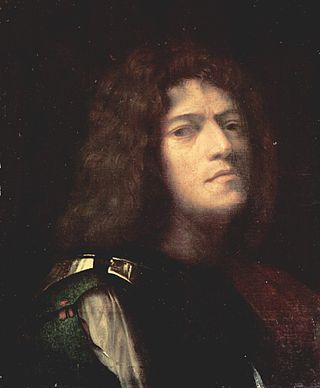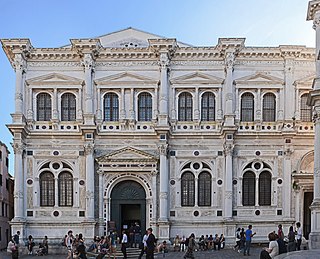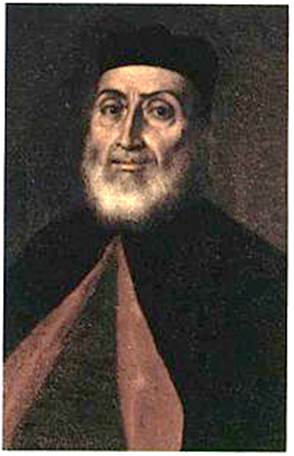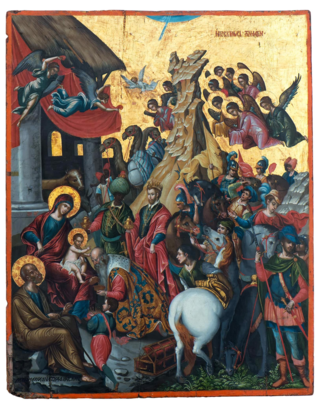
Giorgio Barbarelli da Castelfranco, known as Giorgione, was an Italian painter of the Venetian school during the High Renaissance, who died in his thirties. He is known for the elusive poetic quality of his work, though only about six surviving paintings are firmly attributed to him. The uncertainty surrounding the identity and meaning of his work has made Giorgione one of the most mysterious figures in European art.

Domenico di Tommaso Curradi di Doffo Bigordi, professionally known as Domenico Ghirlandaio, was an Italian Renaissance painter born in Florence. Ghirlandaio was part of the so-called "third generation" of the Florentine Renaissance, along with Verrocchio, the Pollaiolo brothers and Sandro Botticelli.

The Adoration of the Magi or Adoration of the Kings or Visitation of the Wise Men is the name traditionally given to the subject in the Nativity of Jesus in art in which the three Magi, represented as kings, especially in the West, having found Jesus by following a star, lay before him gifts of gold, frankincense, and myrrh, and worship him. It is related in the Bible by Matthew 2:11: "On entering the house, they saw the child with Mary his mother; and they knelt down and paid him homage. Then, opening their treasure chests, they offered him gifts of gold, frankincense, and myrrh. And having been warned in a dream not to return to Herod, they left for their own country by another path".

Pietro Longhi was a Venetian painter of contemporary genre scenes of life.

Paolo Farinati was an Italian painter of the Mannerist style, active in mainly in his native Verona, but also in Mantua and Venice.

Jacopo Bassano, known also as Jacopo dal Ponte, was an Italian painter who was born and died in Bassano del Grappa near Venice, and took the village as his surname. Trained in the workshop of his father, Francesco the Elder, and studying under Bonifazio Veronese in Venice, he painted mostly religious paintings including landscape and genre scenes. He often treated biblical themes in the manner of rural genre scenes, portraying people who look like local peasants and depicting animals with real interest. Bassano's pictures were very popular in Venice because of their depiction of animals and nocturnal scenes. His four sons: Francesco Bassano the Younger, Giovanni Battista da Ponte, Leandro Bassano, and Girolamo da Ponte, also became artists and followed him closely in style and subject matter.

Hugo van der Goes was one of the most significant and original Early Netherlandish painters of the late 15th century. Van der Goes was an important painter of altarpieces as well as portraits. He introduced important innovations in painting through his monumental style, use of a specific colour range and individualistic manner of portraiture. From 1483 onwards, the presence of his masterpiece, the Portinari Triptych, in Florence played a role in the development of realism and the use of colour in Italian Renaissance art.

Giovanni Girolamo Savoldo, also called Girolamo da Brescia, was an Italian High Renaissance painter active mostly in Venice, although he also worked in other cities in northern Italy. He is noted for his subtle use of color and chiaroscuro, and for the sober realism of his works, which are mostly religious subjects, with a few portraits. His portraits are given interest by their accessories or settings; "some even look like extracts from larger narratives".

The Scuola Grande di San Rocco is a building in Venice, northern Italy. It is noted for its collection of paintings by Tintoretto and generally agreed to include some of his finest work.

The Adoration of the Shepherds is a painting of the traditional subject which was painted during the last year of El Greco's life. The painting is a work which the artist made to hang over his own tomb in the convent of Santo Domingo el Antiguo in Toledo. His signature, in Greek, may be seen in the lower left corner.

Gaspare Diziani was an Italian painter of the late-Baroque or Roccoco period, active mainly in the Veneto but also in Dresden and Munich. The artist's canvas is the largest painting of the Hermitage Museum in St. Petersburg.

Pietro di Francesco degli Orioli was an Italian painter of the Renaissance period.

The Nativity of Jesus has been a major subject of Christian art since the 4th century.

Nikolaos Koutouzis, or Koutousis was a Greek painter, poet and priest. He was part of the Heptanese School, but also a member of the Modern Greek Enlightenment in art. His teacher was the painter Nikolaos Doxaras. Koutouzis has 136 paintings attributed to him. He was one of the last Greek painters to incorporate the Venetian style during its decline, due to the Fall of the Republic of Venice. He was the teacher of Nikolaos Kantounis, who was heavily influenced by his style.

The Adoration of the Shepherds is a painting of 1633–34 by the French painter Nicolas Poussin (1594–1665), now in the National Gallery, London. It is in oils on canvas, and measures 97.2 by 74 centimetres. Unusually for Poussin, it is signed "N. Pusin.fe" ["fecit"] on the stone at lower right. By 1637, soon after it was painted, it was owned by Cardinal Gian Carlo de' Medici (1611–1663), the second son of Grand Duke Cosimo II of Tuscany and was placed in his villa outside Florence.

Adoration of the Christ Child, is a c. 1619–1621 oil on canvas painting of the Nativity by the Dutch Golden Age artist Gerard Honthorst in the collection of the Uffizi in Florence.

Adoration of the Shepherds is the title of a lost drawing by Raphael, described in a letter of 8 September 1508, from Raphael to his friend Francesco Raibolini alias Francesco Francia. This letter's contents were first published in 1678, in Carlo Cesare Malvasia's book Felsina Pittrice. Malvasia gave a full account of the letter, which he claimed to have found among the papers of Count Antonio Lambertini in Bologna. While the existence and contents of the letter are disputed, according to Malvasia it described the delivery of a drawing of the Adoration of the Shepherds to Francesco Francia. This drawing has been considered lost or never to have existed.

The Adoration of the Shepherds by Giovanni Cariani is a panel painting of about 1515-1517, now in the Royal Collection of the United Kingdom. The painting is somewhat damaged, and also seems to have been subject to significant changes of intention during the process of painting. It was one of the large group of paintings bought by Charles I of England from the collection of Vincenzo II, last of the Gonzaga Dukes of Mantua in 1628. The painted surface measures 73.6 cm × 120.3 cm.

Adoration of the Kings also known as the Adoration of the Magi is a popular tempera painting by Greek painter Michele Damaschino. The painting is roughly the same size as Damaschino's The Last Supper. Both paintings were created around the same period. Michele Damaschino painted in parts of Italy and Greece. He was primarily active in Heraklion, Sicily, and Venice. He is a major representative of the Cretan Renaissance. He was a Cretan Renaissance painter who painted in the Greek mannerisms prevalent at the time. He also blended the style with the Venetian technique creating a new prototype of painting. He was followed by countless artists both Greek and Italian. His version of the Adoration of the Kings is a very important painting because it reveals the mixture of painting styles prevalent in most of his works. The Adoration of the Kings is now in the Monastery of Agia Aikaterini in Heraklion, Crete. It is part of the collection of Saint Catherine's Monastery Mount Sinai, Egypt.

Adoration of the Shepherds is a tempera painting created by Greek painter Stephanos Tzangarolas. The painter was originally from Crete. He was a member of a wealthy Cretan family. He was a teacher and priest. He signed most of his works. He migrated to Corfu. His work period was from 1675 to 1710. He was active during the Greek Baroque period. 22 of his works survived. He was a prominent member of the Heptanese School.




















